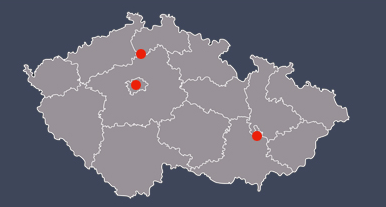
MŠMT
MŠMT
The program is multi-annual thematic program under the auspices of the Ministry of Education, Youth and Sport, within which i tis possible to draw funds from the European Structural and Investment funds (ESIF).
OP VVV
Operation program research, development and education
Supporting the mobility of researches in the Framework in the internationl cooperation.

Basic information: The aim of the project is to build a strong cooperation between the research institutes in Graz and Brno. This is a collaboration in medical research where the recruitment and clinical examination of patients will be carried out by the Austrian workplace, while the DNA analysis will be carried out by the Czech workplace. The co-operation will be accompanied by student exchanges, publication of joint articles in scientific journals, and organization of other joint research activities. The co-operation will include undergraduate and postgraduate students from both departments. A major outcome of the collaboration will be the preparation of at least two joint publications in impact journals from the field of primary pathogenesis research. Research teams are complementary to each other in a very appropriate way. While the Austrian team has an honest experience of detailed clinical examination and patient recruitment, the Czech side has extensive experience in introducing DNA analyzes of all kinds and carrying out large association studies. Methodologically, both teams complement each other in a very appropriate way and allow the conduct of such research, which would not be possible without co-operation. The scientific objective of the project will be to find polymorphisms that interfere with the pathogenesis of primary lymphedema.
Registration No: 8J19AT021
Project duration: 1. 1. 2019 – 31. 12. 2021
Ivestigator: prof. RNDr. Omar Šerý, Ph.D. Institute of Animal Physiology and Genetics CAS, v. v. i.
The program is focused on supporting the initiation and further development of international research cooperation and the development and integration of the Czech Republic into European and world research structures
INTER-EXCELLENCE
INTER-ACTION
International cooperation in research and development with focus on Czech–American cooperation.
Basic information: The aim of the proposed project is to establish a Czech-Americal collaboration to integrate ongoing research, share recent results, expertize, methodology and soft-skills in general to provide unique original data to novel functions of TGF-beta-FasL-Fas-caspase signalling components in osteogenesis published in high quality journals with impact factor.
Registration No: LTAUSA19033
Project Duration: 1. 1. 2020 – 31. 12. 2022, extended to 31. 12. 2023
Investigator: prof. RNDr. Eva Matalová, Ph.D. Institute of Animal Physiology and Genetics CAS, v. v. i.
Gene therapy of neuropathic pain and spasticity via subpial application of AAV vectors in area of spinal cord roots of sciatic nerve and spinal cord injury in minipigs
Basic information: Understanding the molecular mechanisms of chronic neuropathic pain and muscle spasticity is hampered by the absence of suitable large animal preclinical models. Due to its size and comparable physiology with a man, the minipig represents a valuable model for biomedical research. The mission of cooperation of Czech and US teams is to combine the expertise in the field of molecular genetics (AAV9 and AAV.Anc80 vectors design and preparation) and neurosurgery (creation of chronic neuropathic pain and spasticity models). A cornerstone for cooperation is recently developed subpial application of AAV9-UBI-GAD65+VGAT and AAV.Anc80-UBI-GAD65+VGATvectors which permits a well controllable vector delivery into specific spinal segments. The primary goal of our proposed project is to define the safe and clinically-effective dose of subpially-delivered AAV9-UBI- GAD65+VGAT and AAV.Anc80-UBI-GAD65+VGATvectors in ameliorating symptoms of neuropathic pain and muscle spasticity in minipig model. The data generated in our proposed studies will resulted in the common primary publications in well-impacted journals and allow the development of clinical protocol(s) for gene-delivery-based treatments of chronic neuropathic pain and spinal injury-induced muscle spasticity in patients.
Registration No: LTAUSA19029
Project duration: 1. 1. 2020 – 31. 12. 2022, extended to 30. 6. 2023
Investigator: prof. MVDr. Jan Motlík, DrSc. Institute of Animal Physiology and Genetics CAS, v. v. i.
Basic information: The main goal of the project is to understand molecular principles of interaction between selected cellular kinases and the primary cilium. We will (1) define the functional consequences of ICK-mediated phosphorylation of KIF3A and KIF3B in vitro and in cells, (2) identify receptor tyrosine kinases (RTK) that use cilium localization for their function, and describe mechanism and relevance of their cilia compartmentalization, and (3) describe the pathological function of disease-associated RTK variants in formation and function of the primary cilium.
Registration No: LTAUSA19030
Project duration: 1. 1. 2020 – 31. 12. 2022
Investigator: Mgr. Pavel Krejčí, Ph.D. Institute of Animal Physiology and Genetics CAS, v. v. i.
Looking through the evolutionary window: What does introgression of a large gene family across the mouse hybrid zone tell us about speciation?
Basic information: This project brings together two teams that have focused for several decades on different areas of evolutionary biology: the American team is internationally recognized for its research on the evolution of large gene families whereas the Czech team specializes on the study of hybrid zones and mechanisms of speciation. The model for this project is a large family of genes encoding androgen binding proteins (ABP) in house mice, i.e. a cluster characterized by an extraordinary level of expansion. There are two important factors inherent in the model:
- substantial structural differences between two subspecies, Mus musculus musculus (Mmm) and M. m. domesticus (Mmd) creating, where they come into contact in Europe, a narrow hybrid zone; and
- the presence of alternatively fixed alleles in one or more of the Abp paralogs that serve as signals for an assortative choice of sexual partners, which can be an important mechanism of creating a reproductive barrier between incipient species.
Registration No: LTAUSA18178
Project duration: 1. 1. 2019 – 31. 12. 2022
Investigator: prof. RNDr. Miloš Macholán, CSc. Institute of Animal Physiology and Genetics CAS, v. v. i.
Basic information: The goal of the project is to understand of the role of the Aurora kinases and Ran.GTP signaling in the regulation of spindle dynamics and chromosome segregation during oocytes meiotic maturation in mouse. The project have following specific aims: 1. Role of Ran.GTP in spindle formation and maintenance 2. Function of Aurora-A - CDC25B signalling in spindle integrity 3. Role of Aurora kinase C in the spindle formation and chromosome segregation 4. Interplay between Ran.GTP and Aurora B/C kinases signalling in ensuring correct chromosome segregation 5. Cooperation of Aurora kinases in the regulation of spindle dynamics
Registration No: LTAUSA17097
Project duration: 1. 6. 2017 – 31. 12. 2021
Investigator: RNDr. Dávid Drutovič, Ph.D. Institute of Animal Physiology and Genetics CAS, v. v. i.
INTER-COST
The international cooperation in research and development
Basic information: Despite relatively broad and still increasing knowledge in the cell signalling, new pathways or components are emerging and this applies to bone cells as well. With support of the running COST Action and international cooperation, the project aims to elucidate the molecular machinery and new functions involved in the signalling related to molecules such as CD95/CD178 and Myb. The project aims to integrate the most recent findings obtained in frame of research in the applicant´s lab with objectives of the running COST Action in order to expand the results using new approaches and to extend scientific outcomes. The contribution to the network will include new partners to accelerate and improve research with respect to explanation of new mechanisms of molecular signalling in bone-related cells.
Registration No: LTC20048
Project duration: 1. 10. 2020 – 31. 1. 2023, extended to 10. 9. 2023
Investigator: prof. RNDr. Eva Matalová, PhD. Institute of Animal Physiology and Genetics CAS, v. v. i.
Proteomic characterization of cell membrane surface proteins, secretome and exosomes in human cell based Huntington’s disease model.
Anotace: The proposed project aims to analyze the changes in composition of cell surface and secreted proteins of neural stem cells (NSCs) in the presence of mutant huntingtin (mHTT) protein and also changes in proteome and miRNA composition of exosomes secreted by these cells. This will bring new knowledge about developmental changes caused by the presence of mHTT and will contribute to better understanding of cell autonomous and intercellular mechanisms of HD pathogenesis. Specific Aim 1: Characterization of cell surface proteins of control and HD NSCs using cell surface capture technology combined with LC-MS analysis. Specific Aim 2: Analysis of secreted growth factors, cytokines and chemokines in culture medium of control and HD NSCs. Specific Aim 3: LC-MS based proteomic analysis of exosomes secreted by control and HD NSCs. Specific Aim 4: Analysis of miRNA composition of exosomes secreted by control and HD NSCs.
Registration No: LTC18079
Project period: 20. 5. 2018 – 15. 9. 2021
Investigator: Mgr. Petr Vodička, Ph.D. Institute of Animal Physiology and Genetics CAS, v. v. i.






